🐴 📢 Wild #horses return to Spain’s Iberian highlands after 10,000 years.
For the first time in more than 10,000 years, wild horses once again roam Spain’s northwestern highlands. The 35 horses introduced by #Rewilding #Spain are bringing renewed resilience to the land.
In 2023, an initial 16 Przewalski’s horses (Equus ferus przewalskii), the world’s last fully wild horse, were introduced to the municipality of Villanueva de Alcorón in #Guadalajara, a sparsely populated province two hours from #Madrid
If you're looking for sustainable gifts this year, how about a rewilding membership or course? 😊 https://www.youtube.com/watch?v=Jm3-x14GRfA #Rewilding #Nature #Conservation #Environment #GiftIdeas
If you're looking for sustainable gifts this year, how about a rewilding membership or course? :) https://www.youtube.com/watch?v=Jm3-x14GRfA #Rewilding #Nature #Conservation #GiftIdeas
Out latest video on our seagrass project in Scotland, it's been a long journey but the momentum is building! https://www.youtube.com/watch?v=BniwJrxJhcw #Rewilding #Scotland #Seagrass #Ecology #Conservation #Coastal #Ecosystems
🐴 📢 Wild #horses return to Spain’s Iberian highlands after 10,000 years.
For the first time in more than 10,000 years, wild horses once again roam Spain’s northwestern highlands. The 35 horses introduced by #Rewilding #Spain are bringing renewed resilience to the land.
In 2023, an initial 16 Przewalski’s horses (Equus ferus przewalskii), the world’s last fully wild horse, were introduced to the municipality of Villanueva de Alcorón in #Guadalajara, a sparsely populated province two hours from #Madrid
Involuntary rewilding
More good news.
"Our whole organisation was basically premised on the idea that there were people who were willing to let a bunch of young idiots on to their land indiscriminately, to make fairly massive decisions that would affect land value. We didn’t have any evidence that those people existed at the start. We just kind of assumed, or prayed, that they did.”
“I didn’t know I was building a forest” https://www.rewildingmag.com/i-didnt-know-i-was-building-a-forest/
This 90-year-old woman in India offers a lesson on how small, incremental action can lead to meaningful change.
Out latest video on our seagrass project in Scotland, it's been a long journey but the momentum is building! https://www.youtube.com/watch?v=BniwJrxJhcw #Rewilding #Scotland #Seagrass #Ecology #Conservation #Coastal #Ecosystems
More good news.
"Our whole organisation was basically premised on the idea that there were people who were willing to let a bunch of young idiots on to their land indiscriminately, to make fairly massive decisions that would affect land value. We didn’t have any evidence that those people existed at the start. We just kind of assumed, or prayed, that they did.”
“I didn’t know I was building a forest” https://www.rewildingmag.com/i-didnt-know-i-was-building-a-forest/
This 90-year-old woman in India offers a lesson on how small, incremental action can lead to meaningful change.
Beautiful and important piece on #rewilding, what we stand to lose, what we've gained and the hidden costs. (From 2 years ago, worth revisiting).
https://www.codastory.com/climate-crisis/rewilding-beavers-conservation/
Beautiful and important piece on #rewilding, what we stand to lose, what we've gained and the hidden costs. (From 2 years ago, worth revisiting).
https://www.codastory.com/climate-crisis/rewilding-beavers-conservation/
We put a small box in the library to collect seed donations for the community garden, and look at how much has been donated in just a couple of weeks!
A seed library in the making? 👀
#Solarpunk #CommunityGarden #Gardening #Rewilding #GardenLife #MutualAid #LibraryEconomy
We put a small box in the library to collect seed donations for the community garden, and look at how much has been donated in just a couple of weeks!
A seed library in the making? 👀
#Solarpunk #CommunityGarden #Gardening #Rewilding #GardenLife #MutualAid #LibraryEconomy




